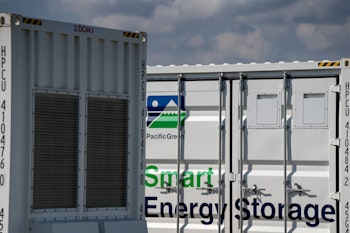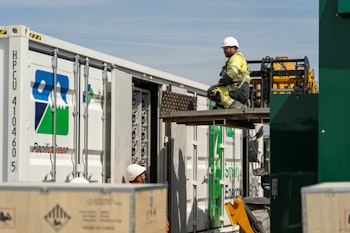
By Dane Wilkins
The UK’s world-leading energy storage market faces a slowdown unless action is taken to address growing barriers to project development.
Two of these—the fact that planning remains complicated, and it is hard to firm grid connections—are ones that affect all renewables, as recognised by the UK Sustainable Investment and Finance Association’s Financing the Future energy policy paper.
“Ensure there is adequate grid capacity to reduce connection times” and “overhaul planning rules to remove obstacles and reduce the time taken to bring large energy projects online,” it recommended.
Plus, there is a third trend that is having an impact on the UK’s attractiveness as an energy storage market. The revenue stack, or the sum of revenues that batteries systems can access by providing different grid services, is being eroded, making it more difficult for developers to finance new projects.
One factor in this is down to chance: batteries make money when energy prices are volatile, and—fortunately for UK energy consumers—the frequency and severity of volatility events in the country has been lower than expected.
Another factor is that frequency response, a grid service that is key to the stability of electricity networks and has been the mainstay of many UK battery plant business plans, is losing its lustre as more and more energy storage competes for a limited market.
All AC grids need to maintain a constant frequency to cope with changes in supply and demand without becoming unstable or wasting energy. In the UK, ability to deliver frequency response is sold to network operator National Grid ESO in regular auctions that distinguish three types of dynamic service:
- Dynamic moderation, which kicks in with half a second and lasts up to 30 minutes to correct unexpected swings in frequency.
- Dynamic regulation, which takes care of non-emergency frequency shifts and lasts from two seconds to an hour.
- Dynamic containment, which lasts from half a second to 15 minutes and is used to correct faults.
The need for rapid response times has traditionally given batteries an edge over slower-starting generation assets when it comes to the provision of these services. And it is an edge that has been handsomely rewarded, with frequency response typically accounting for more than 70% of UK BESS revenues.

However, the value of frequency response has fallen as more and more battery plants enter the market. In May 2023 prices in the UK’s Firm Frequency Response auction had hit their lowest level since 2019, according to data from analysis provider Modo Energy.
The reference price for the tender was £5.69 per MWh, a 16% drop on April 2023 levels way below the £20-plus rates seen from September to November 2022, Energy Storage News reported.
By September, Smart Energy International noted: “Frequency response markets, now saturated, will become a less important part of the BESS [battery energy storage system] revenue stack in the future.
“Although there are signs of increased prices with procurement uplift, this price response is unlikely to be significant, considering the strong battery storage pipeline in development, which will compete for these contracts.”
Frequency response revenues fell by a further 44% between November and December 2023, marking the second consecutive month of 40%-plus declines, Modo Energy said. Prices for all dynamic services fell between October and December 2023, according to Modo Energy.
Dynamic regulation pricing was particularly hard hit in 2023, falling from more than £18 per MWh in January to £6.36 in December. The upshot has been a fall in overall battery plant revenues too.
In September 2023, a report by research firm LCP Delta showed average profits in the UK’s battery storage market had fallen 71% compared to highs in 2022 and 2021.
“Until recently, BESS in Great Britain had been trading profitably by allocating almost all volume to frequency response markets, in particular Firm Frequency Reserve and Dynamic Containment services,” LCP Delta said.
“However, as these markets have become saturated, achieving high returns with a relatively simple strategy will not be possible.”
This trend was entirely expected, said LCP Delta partner Chris Matson.
“The high revenues achieved in 2021 and 2022 were never going to be sustainable and traders, investors and asset owners will need to re-familiarise themselves with the landscape they are now operating within and understand potential challenges,” he commented.
An attractive market, in jeopardy
But these falls in income have been exacerbated by a decrease in the floor price offered in optimisation contracts, the long-term offtake contracts that utilities offer to battery developers and that form the basis of financing for many projects.
Optimisation contract price falls have fallen by far more than the rate of cost reduction in the battery industry, making it harder to secure funding for new schemes at a time when the UK should be ramping up its energy storage capacity.
In a sign of the troubles facing developers, the latest UK T-4 Capacity Market auction—where the spare headroom needed for safe grid operations four years from now is sold to energy providers—attracted 21% less battery capacity than a year previously, despite having the highest clearing price ever.
National Grid foresees the need for at least 13 GW and 44 GWh of energy storage capacity by 2030 even under its falling short outlook, one of four future energy scenarios published in July 2023—and the only one that does not meet the UK’s 2050 net zero climate commitment.
Yet the amount of battery storage currently in operation is just 3.5 GW. This will have to be increased almost tenfold by 2030 to meet the least ambitious of National Grid’s net zero-achieving future scenarios.
While the UK battery storage pipeline increased to almost 85 GW in 2023, it is hard to see all this capacity being commissioned given the current challenges in the market.
Fears for the UK’s energy transition have been echoed in the Financial Times, which claimed: “In recent months, there has been much speculation among UK energy specialists about whether the government’s flip-flopping on green commitments might deter the investment needed to build a competitive renewables industry.”
Perhaps nowhere is this fear more keenly apparent than in energy storage. The UK is still attractive for developers, but unless current challenges are tackled then they will increasingly head abroad for new projects.
Publish date: 25 March, 2024